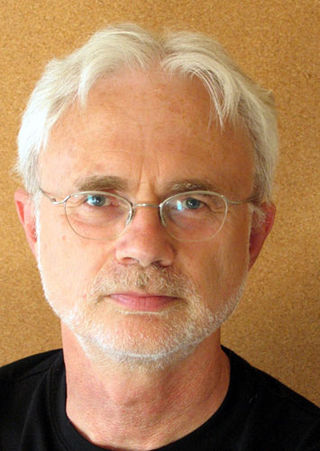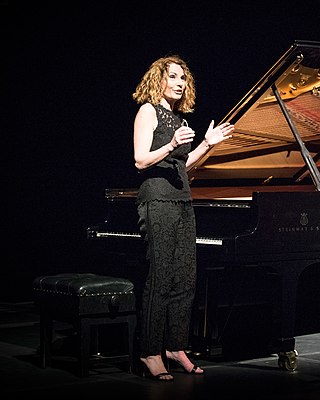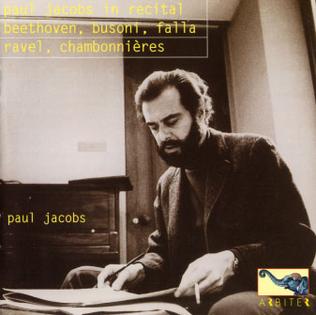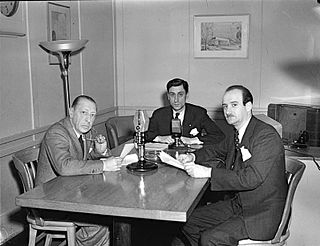Related Research Articles

John Coolidge Adams is an American composer and conductor. Among the most regularly performed composers of contemporary classical music, he is particularly noted for his operas, many of which center around historical events. Apart from opera, his oeuvre includes orchestral, concertante, vocal, choral, chamber, electroacoustic, and piano music.

The Violin Concerto by the American composer John Adams was written in 1993. Its premiere was on January 19, 1994, by Jorja Fleezanis with the Minnesota Orchestra, conducted by Edo de Waart, at the Ordway Music Theater, Saint Paul, Minnesota.

Esa-Pekka Salonen is a Finnish conductor and composer. He is the music director of the San Francisco Symphony and conductor laureate of the Los Angeles Philharmonic, Philharmonia Orchestra in London and the Swedish Radio Symphony Orchestra. In 2024, he announced his resignation from the San Francisco Symphony upon the expiration of his contract in 2025.

Joanna Clare MacGregor is a British concert pianist, conductor, composer, and festival curator. She is Head of Piano at the Royal Academy of Music and a professor of the University of London. She was artistic director of the International Summer School & Festival at Dartington Hall from 2015 to 2019.
Phrygian Gates is a piano piece written by minimalist composer John Adams in 1977–1978. The piece, together with its smaller companion China Gates, written for the pianist Sarah Cahill, is considered by Adams to be his "opus one". They are, according to his own claims, his first compositions consisting of a coherent personal style. It was commissioned and written for the pianist Mack McCray, and first performed by him in the Hellman Hall, San Francisco on March 17, 1978. The work was funded by a group of the board of trustees of the San Francisco Conservatory of Music.
Harmonielehre is a 40-minute orchestral composition by the American composer John Adams, composed in 1985. In his memoir, Adams wrote that the piece "was a statement of belief in the power of tonality at a time when I was uncertain about its future" and that it was "a one-of-kind [sic] once-only essay in the wedding of fin-de-siècle chromatic harmony with the rhythmic and formal procedures of Minimalism".

Gerald Barry is an Irish composer.
China Gates is a short piano piece composed by the minimalist American composer John Adams in 1977.

Paul Jacobs was an American pianist. He was best known for his performances of twentieth-century music but also gained wide recognition for his work with early keyboards, performing frequently with Baroque ensembles.
This is the discography of Simon Rattle and other produced works by the English conductor.
The Piano Concerto No. 2 in G major, Sz. 95, BB 101 of Béla Bartók is a musical composition for piano and orchestra. The work, which was composed between 1930 and 1931, is notorious for being one of the most difficult pieces in the repertoire. Playing time is 26–29 minutes.
American Berserk is a short composition for solo piano by the American composer John Adams. The work was commissioned by the Carnegie Hall Corporation for the pianist Garrick Ohlsson, to whom the piece is dedicated. The first performance took place on February 25, 2002, at Carnegie Hall, New York City, with Ohlsson on the piano.
Thomas Rajna was a British pianist and composer of Hungarian birth. He had been domiciled in Cape Town in South Africa since 1970.
Walter, Knight Boeykens was a Belgian conductor and a world-renowned clarinetist. Boeykens' impressive discography, including several critically acclaimed performances, are testimony to his status as one of the most notable clarinetists of the 20th century. Boeykens remained active and was in concert frequently all around the world until his death in 2013.
Jeroen van Veen is a Dutch classical pianist and composer. He has worked both as a soloist and in collaboration with other pianists. Some of his collaborations include duo work with his brother Maarten and his wife Sandra.
The Diapason d'Or is a recommendation of outstanding (mostly) classical music recordings given by reviewers of Diapason magazine in France, broadly equivalent to "Editor's Choice", "Disc of the Month" in the British Gramophone magazine.

Igor Stravinsky wrote the Ebony Concerto in 1945 for the Woody Herman band known as the First Herd. It is one in a series of compositions commissioned by the bandleader and clarinetist featuring solo clarinet, and the score is dedicated to him. It was first performed on March 25, 1946 in Carnegie Hall in New York City, by Woody Herman's Band, conducted by Walter Hendl.
The Dharma at Big Sur is a composition for solo electric violin and orchestra by the American composer John Adams. The piece calls for some instruments to use just intonation, a tuning system in which intervals sound pure, rather than equal temperament, the common Western tuning system in which all intervals except the octave are slightly impure. The piece was composed in 2003 for the opening of Walt Disney Concert Hall in Los Angeles and was conducted by Esa-Pekka Salonen. The electric violin solo was written for violinist Tracy Silverman.
Naive and Sentimental Music is a symphonic work by American composer John Adams. The title of the work alludes to an essay by Friedrich Schiller, On Naïve and Sentimental Poetry, that contrasts a creative personality that creates art for its own sake versus one conscious of other purposes, such as art’s place in history. The composer cites both the slowly developing harmonies of Bruckner's Fourth Symphony and the atmosphere of the Sonoma coastline as inspirations for the work. The piece was co-commissioned by the Los Angeles Philharmonic, the Ensemble Modern, the Vancouver Symphony Orchestra, and the Sydney Symphony Orchestra. It received its first public performance by the Los Angeles Philharmonic conducted by Esa-Pekka Salonen on February 19, 1999. A recording by Salonen and the Los Angeles Philharmonic was subsequently released by Nonesuch Records.
Christina and Michelle Naughton are twin sisters and an American piano duo.
References
- ↑ Allan Kozinn (March 23, 2005). "Beyond Minimalism: The Later Works of John Adams". The New York Times . Retrieved 2011-09-22.
- ↑ John Adams. "Hallelujah Junction: the book". John Adams' website. Archived from the original on 2012-04-07.
- 1 2 Anna Kisselgoff (January 24, 2002). "What's Black and White and Rhythmic All Over? Ask Peter Martins". The New York Times . Retrieved 2011-09-22.
- 1 2 John Adams. "Hallelujah Junction, for two pianos". Los Angeles Philharmonic . Retrieved 18 April 2011.[ permanent dead link ]
- ↑ Hallelujah Junction, for 2 pianos at AllMusic
- ↑ Stravinsky: Concerto for 2 pianos; Adams: Hallelujah Junction; Boulez: Structures, Book 2 at AllMusic
- ↑ Lewis, Uncle Dave. John Adams: Road Movies at AllMusic
- ↑ John Adams: Road Movies; Hallelujah Junction; Phrygian Gates; China Gates at AllMusic
- ↑ Manheim, James. John Adams: Complete Piano Music at AllMusic
- ↑ Manheim, James. Junctions at AllMusic
- ↑ Christina Naughton & Michelle Naughton, Messiaen | Bach | Adams – Visions (2016, CD) , retrieved 2021-04-05
- ↑ Adams - Jeroen van Veen – Piano Music (2017, CD) , retrieved 2021-04-05
- ↑ Call Me By Your Name (Original Motion Picture Soundtrack) (2018, 180g, Vinyl) , retrieved 2021-04-05
- ↑ "Pose" Pilot (TV Episode 2018) - IMDb , retrieved 2021-04-05